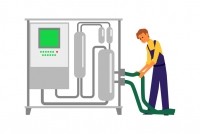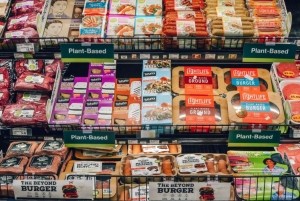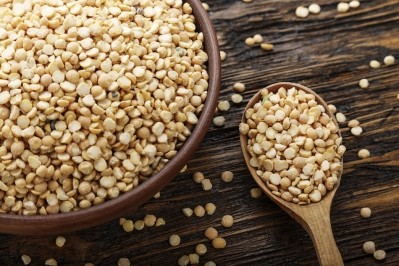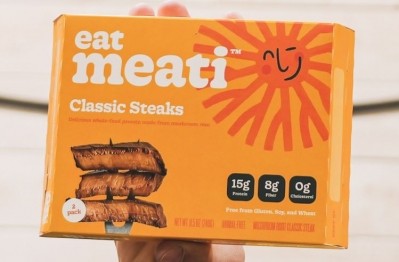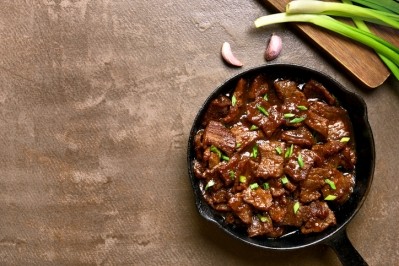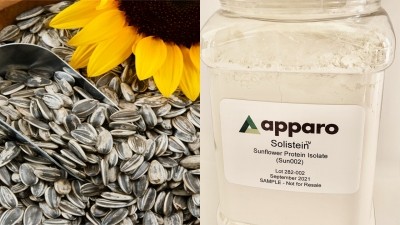Is the party over for meat alternatives? It’s just getting started, says ADM

ADM - which supplies a wide range of ingredients used in meat alternatives, from plant-based proteins such as soy, pea, and wheat, to colors, flavors, oils and fats, starches, texturants, and beans and pulses – is feeling pretty bullish, says Allyson Fish, president, global plant and alternatives proteins.
“There is a lot of noise in the market right now and we're having to answer a lot of questions as these articles [querying the market potential of meat alternatives] keep coming in. And there are challenges the industry needs to address around taste, texture, and price,” Fish told FoodNavigator-USA.
That said, she added, “We're not really seeing any downturn in the market from where we're sitting. And we don't expect there to be a significant change in the trajectory or our expectation of growth in this industry in the next 10 years.”
‘We’re seeing some changes in consumer buying behaviors, but we're not seeing an overall slowdown in the meat alternative space’
Prices have to come down, especially in the current environment, as consumers’ budgets are tightening, and there are still taste and texture challenges, she said. However, the fundamental drivers behind so-called ‘alternative’ proteins haven’t changed, with the major meat and dairy companies themselves recognizing that we need to find more sustainable ways to feed more people with fewer resources.
“So we need to come up with all kinds of novel solutions, including new alternative proteins in order to serve that growing population. So maybe it won't have those 40% CAGRs that some people came out with, but it's still going to be very healthy [growth]. So I’d say, we’re seeing some changes in consumer buying behaviors, but we're not seeing an overall slowdown in the meat alternative space and our customers are asking for more capacity.”
Asked about syndicated retail data showing that US retail sales of plant-based meat were flat last year, she added: “So in the data you see some reduction in retail, and some reduction in [sales of refrigerated plant-based] burger and sausages, but you see high growth in foodservice, you see a lot of growth in private label, and so on, and so we're not seeing a slowdown in business.”
‘Asia Pacific is a huge opportunity’
She added: “The other thing to note is that a lot of this data is coming out of the United States retail market, but this is a global economy and each of the regions are at different stages of evolution. For example, Asia Pacific is a huge opportunity that we're just starting to penetrate and I think there, food security is going to drive a lot of the adoption and a lot of the investment from the local governments in this [area of alternative proteins].”
ADM, which recently opened a pea-protein plant in Enderlin, North Dakota, “recently announced our expansion [at ADM’s soy protein concentrate plant] in Decatur, where we're going to almost double our textured protein capacity,” said Fish.
“We’re also adding a very large protein innovation center because we want to have a space where we can pilot new technology quickly and accelerate its commercialization by bringing everyone from processing to end use applications together in one space.
“And that complements our acquisition of [Serbian soy ingredients specialist] Sojaprotein, where we wanted to bring locally sourced solutions to the European market. And then we have a joint venture with [Brazilian beef producer] Marfrig to create PlantPlus Foods [which is dedicated to plant-based protein products].”
Whole muscle meat alternatives
One area where ADM sees a lot of opportunities is in ‘whole muscle’ meat alternatives, said Fish.
“How do we how do we create that whole muscle-like texture for chicken breasts, steaks, chops?
“We're spending a lot of time on high moisture extrusion technologies and working with our customers to achieve very specific textures and sensory experiences. Something like 26% of meals have a whole breast or whole meat pieces in their traditional family style meals, whereas on the plant-based side, it's actually only 12 or 13%. So what can we do there to enhance that as an opportunity?”
‘We've been doing a lot of trials with the PowerHeater’
One texturizing technology ADM is testing is the PowerHeater, developed by Danish firm Source Technology, which can produce high moisture meat analogs (this involves combining plant proteins and other ingredients with water and oil to form an emulsion which is pumped through the PowerHeater, where it is heated by indirect thermal energy to coagulate the proteins, which emerge from the die with a “laminated, fibrous, structure”).
According to Fish: “We've been doing a lot of trials with the PowerHeater; the chicken chunks we had coming out of the PowerHeater, the chunks of that chicken were so dense and rich.
“It's an interesting technology very similar to high moisture extrusion and I think something that we are continuing to look at is how do we bring a portfolio that services those types of processes to enable this to be an accessible reach? Because mycelium [which companies such as Meati and MyForest are using to make whole cut products] is not going to be fully commercialized at the scale that we need to accelerate this in order to extend this whole muscle opportunity in the near term.”
As for high moisture extrusion, she said, “I see a lot of investment in this space right now. But it does have to be localized because there is the cold chain factor [high moisture meat analogs must be kept cold, whereas low moisture extrusion products (TVP) can be dried, stored and transported as a shelf stable ingredient and rehydrated when ready for use].”
‘Plant-based has been too focused on burgers and sausages’
She added: “I think plant-based has been too focused on burgers and sausages, which by the way are not necessarily global foods. So the question is how do we go about applying these technologies and making meat alternatives more relevant to local audiences around the globe?”
‘We see lots of different ways that we can participate in that [cell-cultured meat] space’
As for cell-cultured (a.k.a. cultivated) meat, ADM has invested in Israeli startup Future Meat Technologies, but is also working with Eat Just’s GOOD MEAT division to help bring down the cost of growth media and help improve the flavor and texture of the first wave of products, which will be hybrids combining cell-cultured and plant-based meat, she said.
“We see lots of different ways that we can participate in that [cell-cultured meat] space. We have a large flavor house and we have food scientists and chefs that are working with a number of our ventures partners to help them accelerate their product development.”
Chickpeas and sunflower… plant proteins to watch?
Asked about diversifying the protein sources used in meat alternatives, Fish said: “We’ve looked at all of them and for us, soy is still king with the best price, the best functionality and the best flavor, but we’re also seeing a lot more demand and pull on the pea [protein] side.
“As we look to expand and bring more concentrates and isolates to the market, we're focusing in on chickpea and sunflower, we think that they have tremendous opportunity.
“Whether we do that through partnerships or through our own build and capability, we're still trying to define that.”
Through its ADM Ventures arm, ADM has invested in a series of startups from Air Protein (which uses microbes that can carbon dioxide into food with the help of hydrogen from water) and Nature’s Fynd (fungi) to precision fermentation companies Perfect Day (animal-free dairy proteins) and Geltor (animal-free collagen); to Israeli cultivated meat firm Future Meat Technologies.
‘We do believe microbial fermentation is essential to part of the future of this space’
Asked about other protein sources, she said: “Some of the other sources like lupin or algae or some of the ancient grains, it's a little harder to bring those in on a large scale and consumers are less aware of them, so it takes a lot more education to bring them up to speed.
“We are also really supportive of mycoprotein and believe that will be a great solution in the near future, although part of the challenge is how do we educate the consumer on where that comes from and how it is made.”
As for fats, she said: “We do believe microbial fermentation is essential to part of the future of this space and we do believe that alternative fats will be a great way to help overcome some of the challenges around mouthfeel and the sensory experience of meat and dairy alternatives.
“We think fermentation is a huge opportunity. We have been working in fermentation for years and we're trying to bring that expertise to this industry.. so to that end, we’re working with Temasek to provide food grade fermentation support and access to capacity for startup companies.”
* Source: IRI, Integrated Fresh, Total US, MULO
Meat alternatives by numbers
Dollar sales of plant-based meat alternatives dipped slightly (-0.9%) to $118m in measured US retail channels* in May 2022 vs May 2021, with solid +10.1% growth in the frozen aisle offset by a -16.1% drop in the refrigerated aisle, where sales of plant-based refrigerated patties slumped by -37.3% year-on-year (YoY), sales of grounds fell -26%, and sales of dinner sausage dropped -6.8%, according to IRI data* crunched by 210 Analytics.
Volumes (lbs sold) of plant-based meat alternatives fell -7.3% YoY, with frozen meat alternatives again fairly flat (-0.8%), but refrigerated alt meat volumes falling precipitously (-18.1%).
By contrast, total meat department dollar sales – which experienced more of an inflationary boost than their plant-based counterparts - were up +4.5% to $8.1bn in May 2022 vs May 2021, with volumes down -6.1% YoY.
Price per pound, fresh alt-meat ($8.28/lb) vs fresh conventional ($4.31/lb)
In the refrigerated segment, while the price of regular meat has risen steadily in recent months, the price gap between conventional and alt meat remains wide, with refrigerated meat alternatives averaging $8.28/lb in May 2022 (+2.4% YoY) vs $4.31/lb for conventional fresh meat (+8.8% YoY).
Source: IRI, Integrated Fresh, Total US, MULO
